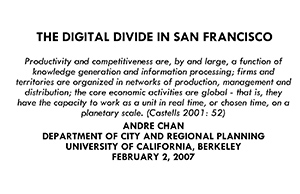The digital divide is defined as the access – or lack thereof – to technology at home (U.S. Dept of Commerce October 2003). Recent studies have shown the digital divide can be identified and measured according to seven at-risk socio-economic groups: Race, Gender, Age, Educational Attainment, Income, Disability and Employment Status (Selhofer and Hüsing 2002, European Commission 2003, Hüsing 2004, Fox/Pew Internet, 2005). The following report analyzes the first four groups, based on readily available data.
An analysis of digital divide indicators for San Francisco and comparison cities indicates there is a substantial digital divide in San Francisco, and that it is more acute in San Francisco than in comparison cities. Data from the 2003 U.S. Current Population Survey indicates that one-third of the residents in San Francisco do not have access to a computer or the Internet at home. While the total population of San Francisco ranks in the middle of comparison city rankings, all of the at-risk socio-economic groups in San Francisco are below average, lagging at or near the bottom of the comparison city rankings in terms of absolute percentage with access to technology at home. Educational attainment exhibits the largest and most consistent gap of all at-risk socio-economic groups in San Francisco and across all comparison cities, and is most acute in San Francisco for people who completed high school but did not attend college. San Francisco exhibits the largest gender gap for women, the largest age gap for seniors, and a substantial race gap for nonwhites (including Hispanics).

